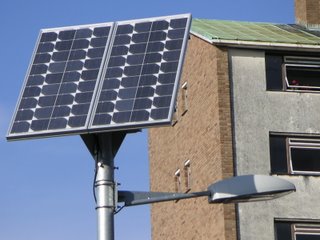The Warmth of Renewable Energy
Quietly springing up around campus have been a set of solar-powered streetlights - the only one's I've seen so far have been one outside Penbryn and three behind the TV/Film building - if you've seen any others elsewhere on campus flag it up here (there should be 20 in total)! Pictures here are from the one outside Penbryn...

So, how's it work? These are photovoltaic (PV) solar cells, which means that electricity is generated using sunlight (not sunshine, so they still work on an overcast day and don't need to be in direct sunlight), stored in a battery during the day, and kicks in at night to power the streetlight.
Solar radiation is converted into energy - PV cells consist of layers of a semiconducting material - most commonly silicon, and when sunlight shines onto the cells, and electric field is generated across the layers (physics students please correct me here).
 Solar energy is 100% renewable (well, at least until the Sun dies out and all that) so there are no fuel costs, just the initial costs of purchasing and installing the units and maintenance thereafter - which over its lifetime will be more than recovered through electricity savings (no need to take power from the coal-fired plants off national grid, thus cutting carbon emissions and fighting climate change)!
Solar energy is 100% renewable (well, at least until the Sun dies out and all that) so there are no fuel costs, just the initial costs of purchasing and installing the units and maintenance thereafter - which over its lifetime will be more than recovered through electricity savings (no need to take power from the coal-fired plants off national grid, thus cutting carbon emissions and fighting climate change)!The overall impact of these streetlights will be pretty small compared to the overall carbon emissions of the university - but it's a start.
Small-scale installations like these are known as 'microgeneration' sources - so they are integrated into existing structures and buildings instead of being built on an large solar-farm development (e.g. in Australia)
These panels are oriented towards the south - this is to enable maximum sunlight capture - and the greater the intensity of the light, the more power generated!
Want to install your own PV cells on your roof? Contact the Energy Saving Trust for advice, especially on grant schemes available that can sometimes cover up to 50% of the costs.

0 Comments:
Post a Comment
<< Home